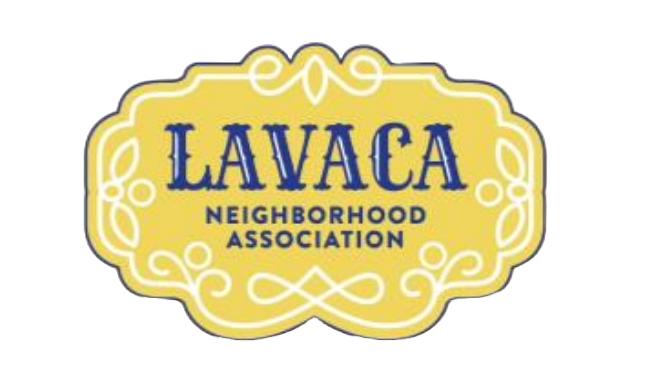Our Association
About Us
The objective of the Lavaca Neighborhood Association is to enhance the livability of our neighborhood by working to create and maintain a beautiful, safe, and healthy environment for all.
Stay Informed
To receive updates about neighborhood updates, meetings, and events you can:
Follow us on Facebook or Instagram
Sign Up for the our email newsletter
Get Involved
Get Involved
Attend our General Membership meetings which occur on the third Tuesday of every other month in January, March, June, August, October, and December. Bring your family, friends, and neighbors!
Our LNA Board meets on the 1st Tuesday of each month. Want to attend? Contact president@lavaca.net
*48 hour notice required to attend LNA Board Meeting
Our Board
The Lavaca Neighborhood Association Board of Directors is an all-volunteer committee of neighbors who give their time and talents to serve the neighborhood.
Executive Board members (president, vice president, secretary, treasurer) are elected for two year terms, with a maximum of two consecutive terms, at the annual membership meeting in January.
The immediate past President may serve as President Emeritus on the current Board of Directors for one term immediately after the end of their term as President.
The other committee directors are appointed by the Board at the January meeting or as openings become available.
The Business Owner Director may live outside of Lavaca as long as their business is physically located within the Lavaca boundary area.
The Board meets on the first Tuesday of each month at 6:30pm. Any LNA member may attend a Board Meeting with at least 48 hours notice. To attend a Board Meeting, contact president@lavaca.net at least 48 hours in advance.
The 2023 LNA Board of Directors:
Melissa Stendahl, President
VACANT, Vice President
Kat Doucette, Secretary
Nataly Jennings, Treasurer
Sarah Cardenas, Communications
Vik Gudi, Membership
Lynda Ann Price, Events & Fundraising
Brian Murphy, Neighborhood Development
Marcy Newman, Transportation & Public Safety
Mike Abad, Local Business Owner
Stephanie Faulkner, Member At-Large
Our Neighborhood
The Lavaca Neighborhood is the oldest residential neighborhood in San Antonio.
It is bounded on the north by César E. Chávez Boulevard (formerly Durango St.), on the south by the Missouri-Kansas Railroad Line, on the east by IH-37, and on the west by South St. Mary’s Street. The Lavaca area is defined by its small 19th century vernacular houses built primarily by working class families beginning in the early 1870s. This was approximately the same time that affluent San Antonians were building much larger homes several blocks away in the King William neighborhood. The neighborhood’s original residents included carpenters, stonemasons, shopkeepers, clerks, tailors, bartenders, teamsters and butchers. The houses are primarily 1-story with some 2-story buildings interspersed, and range from the very simple to the highly decorated; notable styles are the vernacular stone or caliche block cottage, Victorian cottage, two-story Victorian, Craftsman and a few Neoclassical.
The area was originally part of the Labor de Afuera, the farmlands of Mission San Antonio de Valero (the Alamo) which were watered by the Acequia Madre, an irrigation ditch built by the Spanish in the 18th century. The mission lands were subdivided into suertes (smaller pieces of land based on a Spanish unit of measure) in the early 19th century, and the property was owned by individuals. By the middle of the 19th century, land speculators including Thomas J. Devine and Sam Maverick had purchased large tracts in the Lavaca area.
When the Augustus Koch Bird’s Eye view of San Antonio was published in 1873, the development in the Lavaca neighborhood was well underway, with construction along Lavaca and Barrera Streets. The later 1886 Bird’s Eye View map documents further development in the area. Subdivisions of land made in 1877 on Barrera and Camargo Streets, and in 1888 on Callaghan Avenue, indicate the area’s ongoing development. In the 1890s, Robert and Sarah Eager and William Leigh subdivided land south of Callaghan and along Leigh Street. Along the western boundary of the neighborhood of South Alamo Street, a firehouse, meat markets and beer gardens stood alongside residences. In the early 20th century, 1 and 2-story commercial buildings were constructed.
The first City Directory for San Antonio was published in 1877, and at that time, Lavaca Street residents included families with German, Polish and Hispanic surnames.
Of those listed, Germans were by far the predominant group. African Americans also resided in the area, primarily at the eastern end of the neighborhood that came to be known as “Baptist Settlement”, named for the New Light and Mount Zion Baptist churches, both founded there. The housing in that portion of the neighborhood was razed for construction of the Victoria Courts public housing project in 1941.
The area to the north of Durango Street (now César Chavéz Blvd) was an Urban Renewal area where the portion of what once was the Lavaca neighborhood was razed for the 1968 Worlds Fair.
_________________________
This text is from “The Lavaca Neighborhood Design Guidelines” written and illustrated by Sue Ann Pemberton-Haugh, AIA Mainstreet Architects Inc. as made possible by the Community Partners Program of the National Trust for Historic Preservation through a grant from Pew Charitable Trusts in cooperation with the MainStreet Alliance of San Antonio, Southtown Urban Main Street Program, the Lavaca Neighborhood Association, the City of San Antonio’s Historic Preservation Office and Housing and Community Development Department and the Texas Historical Commission.



